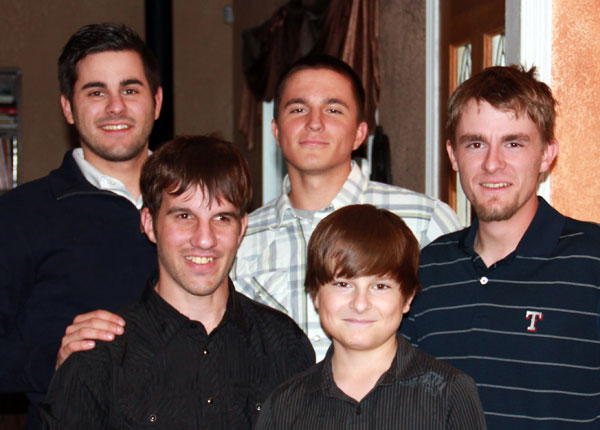Feedback and Its Impact on Behavior, Learning, Development, and More – Part 5
Parent Power or Powerless Parents
by Bob Doman
My son won’t do what I tell him to do.
Mom said, “Stop it!” for the ten-thousandth time.
Why should I?
The kids are out of control.
You’re not the boss of me.
Susie won’t sit at the table and finish her meal.
I can’t get him to do anything.
 Many parents feel powerless to get their children to obey. They try rewards and every “punishment*” under the sky, but the kids still ignore them and do what they want, when they want.
Many parents feel powerless to get their children to obey. They try rewards and every “punishment*” under the sky, but the kids still ignore them and do what they want, when they want.
Even though I’ve heard it perhaps thousands of times, every time I hear an adult, a parent, tell me their little thirty-pound child won’t listen to them and that they can’t get their child to obey, follow directions, stop doing something harmful or dangerous, or do something important for their development and education, I am a bit taken aback. Whether your child is two, ten, or a teen you have power—if you wish to exercise it—to gain control.
Your child can’t eat something unless you buy it; they can’t watch TV, listen to music, play a video game, use an iPad or any screen for that matter unless you let them. They can’t go to the park or do many things unless you facilitate or permit it.
The things your child really likes are the things that provide you with parent power; if you are willing to use your power. Access to favorite foods or treats, access to screens, music, special toys, extra or special events, etc. are not in the category of necessities. They are things you as a parent can choose or not choose to provide. These things need to be perceived by you as special things you are providing for your child; not having them is not deprivation.
If I suggest to some parents that they need to withhold favorite items or activities and use them as rewards for compliance, cooperation, or trying, I will hear comments such as, “Johnny will throw a fit if I limit his screen time!” A parent who is afraid to control their child is the parent of a child who is doing a better job of using rewards and consequences with their parents than the parents are with them.
A rule of thumb with children’s behavior is that they do what works, regardless of how self-defeating it may appear to be. If you tell Johnny he can’t play with the iPad and he throws a fit, he is doing it because throwing a fit works; it gets you to do what he wants. He is punishing your behavior. When you need Johnny to keep himself occupied and stay out of trouble and he quietly spends hours on the iPad, he is rewarding your behavior of letting him do what he wants. If Johnny’s fits didn’t work, he would stop having them. The typical parental response to this is, “I don’t let it work, I don’t give him what he wants.” My response to the parents is, “How consistently do you not give in and let it work?” Even if the parent’s response is, “most of the time,” that isn’t enough. If Johnny believed you, he wouldn’t do it because he knows it’s not going to work. Kids are terrible with odds. You wouldn’t gamble on something with lousy odds, would you? It depends, doesn’t it? You might buy a Powerball ticket with odds of 1 in 292,201,338 with the chance of winning millions. Guess what? To your five-year-old, getting the iPad right this minute is more significant than 100 million dollars to them (at least in part because they may have spent so much time on it that they are now addicts).
Historically I haven’t found that taking everything away from children to be productive. It is and feels to them to be punitive and it doesn’t work. But controlling their one favorite thing, or a few of their favorite things, and having them earn them does work. There is a difference, a significant difference.
There are a few important principles for parents to learn in dealing with their child’s behavior.
Behavior Principle #1
First is the concept of opposite incompatible behaviors. If you take advantage of this concept, in many, if not most cases, you can reward a behavior rather than punishing an opposite behavior. Rewards almost always work better than punishments and they make us as parents feel much better. They also move us toward creating a positive environment.
Examples of Opposite Incompatible Behaviors:
- not staying in bed/staying in bed
- not doing a chore/doing the chore
- siblings fighting/siblings not fighting
- not cooperating/cooperating
- having a lousy attitude/having a good attitude
Behavior Principle #2
Second, if we are trying to start a new behavior, we start with a small demand and a big reward. In the category of behavior, we have everything from a child saying “please”, to a child playing nicely with a sibling, to taking off their socks, to working hard on a processing activity. As we get the new behavior started and are establishing a new behavior pattern, we decrease the intensity/size and the type of the reward.
Behavior Principle #3
Third, always couple a tangible reward such as a treat, a special privilege, or even money, with a “social” reward. A social reward means praise, a hug, a high five, etc. As we build the habit of the new behavior, we decrease or phase out the tangible reward and maintain the “social” reward, albeit perhaps at a less intense level.
Behavior Principle #4
Fourth, if we are using something they like and that is important for them as a reward, if that thing can only be accessed as a reward, it has much greater power than if it is just a way to get more of whatever.
How to Implement These Principles
Let me give you two examples of how to implement these principles:
Example 1:
You have taught little Susie how to make her bed and the expectation is that she will now make her bed before leaving her room in the morning. If Susie does not make her bed, do we come up with a punishment? Do we punish this “bad” behavior or find a way to reward the opposite incompatible behavior? After we have taught her how to make her bed independently, we tell her that we want her to make her bed by herself before she leaves her room and comes to breakfast. To help this brand-new behavior along, we kick-start it with a BIG reward. So, for example, you tell Susie what you want and that you are going to be very proud of her if she does this grown-up thing. If she does it, you will make her pancakes for breakfast with syrup, strawberries, and whipped cream. Then after breakfast, you will go to the park. When she comes out for breakfast, you go into her room with her to see if she has completed her job. If she has, you cheer, pick her up, twirl around and give her a big hug, then proceed to make her pancakes, and then head to the park, all the while taking opportunities to tell her how proud you are of her for making her bed. If it turns out she did not make her bed, say something like, “I’m sad you forgot to make your bed. I was going to be so happy to make you pancakes and go to the park, I bet you can remember to do it tomorrow. Without mentioning it, plain eggs for breakfast and no trip to the park; also do not make a big deal of it all. Any attention has the potential to be rewarding, so drop it and move on.
As we continue with Susie making her bed, we slowly decrease the size and frequency of the tangible reward and to some degree the intensity of the “social” reward. Day two of success may earn the pancakes with all the fixings and the trip to the park. Day three, the pancakes, without the strawberries and whipped cream, but no park. After day six or so, start making the pancakes randomly every two to three days, always praising her for the good job she is doing, and then slowly phase out the pancakes, leaving a new behavior pattern and small social rewards, shifting emphasis to new behaviors. We can now avoid the unhealthy pancakes again or save them to help start another new behavior, but only make pancakes when they are being used to build a new behavior—they’re special and have special power.
Example 2:
Sean spends every possible minute he can watching YouTube on the iPad and when you try to take it away so he can do some reading, chores or other productive activity, he throws a huge fit. Sometimes he wins immediately, and you give up and let him watch his favorite videos. Other times you take it away and fight with him for an hour until he sort-of does what you want and then is immediately back to his screen. Do we punish the negative behavior of throwing a fit and not giving up the iPad, or do be find a way to turn the iPad into power?
In Sean’s case we actually have a few issues. He is addicted to watching/perseverating with YouTube videos, he is being defiant, and he is wasting his day doing an unproductive and harmful activity rather than being present, engaged and learning. To compound the problem, the constant negative attention he was getting from fighting and often winning was making his world extremely negative. The negativity was teaching Sean to work for the negatives, not the infrequent positives. It was defining him to himself and others as a negative, unhappy, and uncooperative child. Used correctly, the iPad could not only provide us with power, but it can be used to develop new positive behaviors.
The first thing I would do with Sean, is to take away the iPad completely for a week or two to start breaking the addiction and to teach him that you, and not he, are in control. Take it away, lock it away, and tell him that he has been watching it too much and that it has become bad for him. Period. No further discussion, no arguments. Of course, he will throw a massive fit, but don’t argue, discuss, or give in. As soon as you convince him that he isn’t getting it (if you have an option like going with him and leaving the iPad at Granddad’s house, use it), he will stop fighting. Kids do what work, and when he decides that you aren’t giving in and that his fit isn’t going to work, he will stop. After a few days of peace, it’s time to use the power.
Our goal is to turn the negative behavior of Sean watching endless YouTube videos into the opposite incompatible behavior of working, cooperating, and doing things that are positive for his growth and development. For Sean there is probably a long list of things you would like to see him do, from specific chores, to reading, working on processing, to math. In the past, every one of these things had become negative and he would either have a tantrum and win or throw a fit and eventually sort of do what was asked, but neither well nor as an active participant.
To start on the road to the new Sean, we would define a task that is definitive, that is clearly accomplished correctly. Examples include things like doing five math problems correctly (make it easy), taking the trash out, or emptying the dishwasher. Sean is told that when he accomplishes his task well he will be permitted to play on the iPad for 10 minutes. If Sean enjoys playing good games or doing things other than watching YouTube, I encourage removing all of the offensive material, including YouTube, from the iPad before giving him access. Upon proper completion of the task, give Sean a lot of positive praise and then set a timer for 10 minutes and immediately let him play for the ten minutes. As you proceed with Sean, you would add more and more projects for him, and while maintaining all of the positive social rewards, you would also increase the demands and decrease the iPad time and start looking for other perhaps healthier rewards. As Sean’s world becomes more and more positive, he will hopefully start perceiving himself differently and being happy, while you are moving the tangible rewards in better directions and slowly phase them out completely. You should also be able to decrease the intensity of the social rewards. It’s important to note that another term for “social rewards” is “adult rewards.” As we teach Sean to be a positive active participant and how it feels to receive positive acknowledgement for his efforts, we are also teaching him to appreciate adult reinforcement and to become more mature and responsible.
Parents, learn not to jump when your child says, “jump.” If you are tired of your child pulling the strings and if you would like to gain control, help your child develop, and make his or her world and your world more positive, use the “power” and remember to use the four principles.
*Punishment—a consequence to a behavior that decreases the frequency of the behavior. If you continue to “punish” a behavior and it is not decreasing or being eliminated, you are in fact not punishing, but may be reinforcing a behavior with attention, possibly being abusive or punitive and definitely creating a negative environment.




